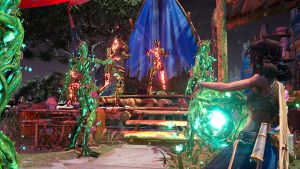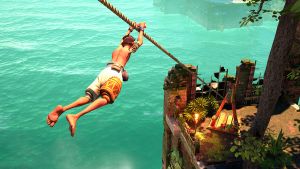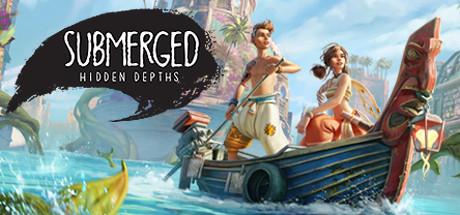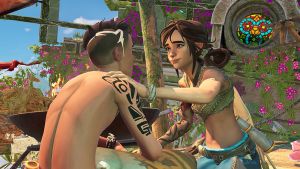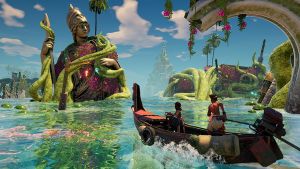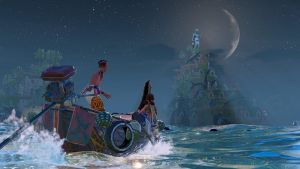|
By flotsam
Submerged: Hidden Depths
Uppercut Games
As it turns out, I pretty much
told you all you needed to know in my first look. Which isn’t a
criticism, rather an acknowledgement that the game continues in the same
gentle exploratory vein as it was described.
To recap, Hidden Depths
describes itself as a "third person, non-combat, relaxploration
adventure", which is an apt description. Miku and her younger brother
Taku are exploring a watery city, one in which a large black plant-like
mass has taken hold, one which “swallows life and spits out copies.”
They are alone, except for strange manifestations of the previous
inhabitants which ‘populate’ the inundated buildings, and an array of
animals and sea creatures.
The deeper story, both of the
city and the siblings, you can discover as you play. It is part of the
appeal of the adventure, with a surprise and a rather good end.
You explore by boat, with the
watery world completely open to you from the start. It’s a big place,
but navigating is part of the fun. Your craft bobs and rocks in the
swell, night becomes day, fog rolls in and it might rain. It’s a
colourful and detailed environment, on and off the water, and I enjoyed
spending time tootling about, seeing what I could see.
The initial part of the game
sets up your primary objective, through a brief exploration of The Dome,
which is your current location and your home base. Miku finds a large
seed, one which needs to be ‘liberated’ and returned to its home.
Carrying it to a bowl shaped pod, she watches in amazement as it
restores life to the black plant. Sensing another seed nearby and what
might be possible, she and Taku take to the sea.
Once aboard, a map becomes
available, although the only item identified at this stage is the nearby
seed. While you can just head off to potentially explore other buildings
you can see, travelling to the nearby seed is a sensible first step. You
will arrive at an old library which is a far smaller construction than
the rest of the places you will visit, and is designed to help you
settle into how the environment works, how you get about and what else
you might find and collect.
More than that, finding the seed
and finishing that location returns you automatically to The Dome and
when you next set off, a telescope is added to your items, a very handy
implement indeed. I have no idea whether it will become available if you
were to find a different seed as a result of simply sailing off into the
watery world, but I can’t see why you would try and find out.
What the telescope does is put
things that you see through it onto your map, making getting there
easier and keeping track of places found and not yet visited. You can
identify all manner of things, not just the location of seeds. Lookouts,
landmarks and locations of other items you can collect (diary pages
predominantly), as well as boat upgrades which float in the sea and
relics which you pull from the depths; all of these will be plotted onto
the map.
Needless to say, much like a
real telescope your vantage point will determine how much you might be
able to discover at any one time, and while I would regularly pause
while on the water to have a look through it, I made a point of whenever
I was up high to see what I could see, especially in directions I hadn’t
yet been. To that end, climbing the lookouts was helpful.
If you do visit a building that
wasn’t previously on your map, it will also then appear; but not every
building you can see is one that you can visit (that is, get off your
boat and explore). However, to my knowledge any place the telescope
identifies can be visited, for one purpose or another, so it helps you
sort out where to go and where you need not bother.
Not everything you can find will
be on your map. In the seed locations there are nine ‘style’ pieces to
be found, which when collected enable you to change the look of your
boat or perhaps your hair. Its just another piece of the exploration
fabric.
Exploring a location is done by
one or other of the siblings, generally by Miku (and always when it came
to collecting the seeds) but occasionally by Taku (near as I can recall
he set out when all that was to be found was a diary page). Whichever
character you might be using, they both operate the same. Played in the
third person, the WASD keys are used to move the character, while the
mouse controls the camera view, and you can usually always shift that
view to one that better suits what it is that is going on. I tended to
keep it behind me, but on occasion I wanted to pull down to look up in
order to see where I might climb, or shift it to around a corner so I
could see what the path ahead. I thought it worked well.
You do climb, and jump, and
swing on ropes and zoom on ziplines and scuttle up pipes. But you do it
without needing to do any of that yourself. If Miku needs to jump a gap,
simply having her move towards the gap will result in a jump. Ditto if
she swings on a set of ropes; just keeping the W key pressed will cause
her to do what is required. And if for someone reason you release the
key halfway through, she will just hang on the rope, patiently waiting
until you press again, at which time she will start her swing up again
and continue on her way.
You might have to make some
decisions about eg. where to go next (do I jump to that next ledge or do
I drop to the one below) and perhaps a ledge might not be wide enough to
walk on but can be traversed by hanging from your fingertips; but there
is no dexterity, or timing, or any danger involved. Miku won’t fall, she
won’t miss a leap, she can’t die, and nothing she does has a time limit.
It accentuates the exploration, encouraging you to look (instead of
being put off by potential tragedy) for all those other things there are
to be found and which might only be reached by getting off the obvious
path (flowers you can find for instance tend to grow halfway up walls),
but still gives you a participatory sense of Lara Croft nimbleness. It's
rather nifty.
Helping you to get about is a
guide colour, which you can set in the options to suit. By default it is
red, and you will quickly find how it assists in eg. where you might
climb or jump. The character will also turn their head to look towards
something of interest, and there are little shimmers and sparkles that
you shouldn’t ignore. So too there are audio clues, and a very detailed
user manual at the game’s Steam page sets them out (and contains a whole
lot of other helpful information).
A little compass ribbon top of
screen with images for things to be found can further assist, and once
you have found all the items in a location a little pop-up will alert
you to that fact. You can’t get stuck, or lost, and the locations are
designed in a way which avoids backtracking; but if you do get confused
however, you can choose to return to the start of an area without losing
your progress.
Within the locations you might
have to manage pressure plates, trigger the release of bridges, open
gates or even tow a platform with your boat into place. None of it is
hard, and all actions are achieved by pressing the ‘E’ key (on the
keyboard) when the hotspot is activated. You will also have to move your
seed around the location, sometimes by carrying it but also by eg.
putting it in a cradle and sending it off somewhere with the pulley
mechanism at hand. Same as before, its all straightforward.
Music is used to heighten the
mood and is another positive element (as is the sound palette
generally). There is some very limited spoken word but it's in a native
language you can’t understand. The main story unfolds through pictograms
and subtitles, and the collected diary pages add the broader tale of the
city. These can be accessed in your journal through a little set of menu
buttons bottom right, or viewed on one of the walls of The Dome when you
return there. You can also display the relics you find in one room of
The Dome, and the flowers on trellises throughout. Your telescope and
map icons are also bottom right, as is a button to put certain things
down (seeds, pressure balls) should you need to. It autosaves on exit,
and just choose continue to start back up where you left off.
You can quick travel to places
you have already been, and while restoring a seed automatically returns
you to The Dome, this means you can get straight back to wherever if you
decide you want to look for things you didn’t find. And assuming you get
to the end of the game without finding everything, you can continue to
explore, although starting a new game will wipe your single save (which
I never like or understand).
There is a lot going on in
Hidden Depths, but it really does accentuate the ‘relaxploration.’ It
leans into what it is about, and packages it up well. You could argue
it’s a bit the same but I spent about 10 hours getting to the end
without finding it dull or limiting, and still have about a third of the
things to find. I was surprised by how much calm enjoyment it gave me
across the several months I dipped in and out of it, and intend to do so
again to find those remaining items.
I played on:
OS: Windows 10, 64 Bit
Processor: Intel i7-9700K 3.7GHz
RAM: Corsair Dominator Platinum RGB DDR4 32GB
Video card: AMD Radeon RX 580 8192MB
GameBoomers Review Guidelines
August 2022
design copyright© 2022
GameBoomers
Group
 GB
Reviews Index GB
Reviews Index |
